Higher education is at an inflection point. As college enrollment continues to decline and pressure mounts to demonstrate return on investment, the federal government has responded with a potentially transformative shift: the creation of Workforce Pell Grants.
Included in the sweeping One Big Beautiful Bill Act (OBBBA) recently signed into law, this expansion of Pell Grant eligibility could open the door to new student populations, new revenue streams, and new institutional strategies — if colleges and universities act quickly and strategically.
What is the Workplace Pell Grant?
Traditionally, Pell Grants have been limited to students enrolled in credit-bearing, degree-seeking programs. That changed with the passage of OBBBA. Workforce Pell expands access to federal financial aid for students enrolled in short-term, non-degree training programs that lead directly to high-demand jobs.
Under the law, students may now use Pell Grants to pay for qualifying workforce training programs that meet the following criteria:
- Are between 150 and 600 clock hours (roughly 8 to 15 weeks of instruction);
- Are offered by eligible institutions of higher education (IHEs)
- Lead to industry-recognized credentials tied to in-demand occupations as defined by the U.S. Department of Labor and/or state workforce boards.
This development reflects a growing bipartisan consensus that higher education must play a more responsive role in preparing learners for rapidly evolving labor market needs.
Why Workforce Pell matters for colleges and universities
The proposed expansion of Pell Grant funding isn’t just a policy update — it’s a strategic opportunity. Here are some key opportunities institutions should be paying attention to:
1. New enrollment markets
Workforce Pell unlocks funding for adult learners, displaced workers, and non-traditional students who may not have the time, resources, or need to pursue a two- or four-year degree. For institutions facing enrollment declines, particularly at the community college level, this represents a powerful new market.
2. Revenue diversification
Short-term credentialing programs — especially those that can scale — offer a way to generate net new revenue without over-reliance on traditional tuition models. With federal aid now available, these programs become more accessible and financially sustainable.
3. Employer partnerships
The law encourages alignment between institutions and regional labor market demands. Institutions that already collaborate with employers or workforce boards will be well-positioned to fast-track qualifying programs and potentially receive direct funding support or partnership commitments.
4. Strategic positioning
Institutions that embrace short-term, skills-based credentialing can position themselves as hubs of workforce development and talent pipelines. This enhances their relevance with local governments, employers, and adult learners alike.
Ready for a Smarter Way Forward?
Higher ed is hard — but you don’t have to figure it out alone. We can help you transform challenges into opportunities.
How can institutions prepare for the Workplace Pell?
Now is the time for higher ed leaders and innovators to act on these policy changes. Here’s where you can start:
1. Audit existing offerings
Begin by reviewing current non-credit or certificate programs. Identify which ones could meet the new Workforce Pell criteria with limited modification—particularly programs already tied to industry credentials and high-demand jobs.
2. Build approval infrastructure
Programs must be approved by the U.S. Department of Education and/or state agencies. Start building a compliance plan, including documentation of program outcomes (e.g., job placement rates, earnings gains) and accreditation alignment. Consider appointing a cross-functional task force including financial aid, academic leadership, compliance, and workforce liaisons.
3. Seek out strategic partnerships
Engage with local employers, chambers of commerce, and workforce boards to validate demand and align curriculum. Public-private partnerships can strengthen program justification and outcomes data—key elements for gaining approval and maintaining eligibility.
4. Invest in marketing and outreach
Many potential Workforce Pell students are not currently in your database. Institutions must rethink marketing strategies to reach adult learners, incumbent workers, and individuals navigating career transitions. Messaging should highlight affordability, short duration, and job outcomes.
5. Track the data
Institutions must monitor the performance of Workforce Pell students and programs. The Department of Education will evaluate outcomes like employment rates and earnings. Underperforming programs may lose eligibility, so building robust reporting systems is not optional — it’s critical.
A new era of credentialing is coming
The Workplace Pell Grant represents more than a funding change — it’s a shift in federal policy philosophy. It signals growing recognition that short, focused training can be just as powerful as a traditional degree in driving upward mobility.
This policy has the potential to reshape the education market within a few years, favoring modular, job-connected learning and expanding access for nontraditional students. For institutions ready to lead, the opportunity is clear.
At Collegis, we partner with institutions to navigate policy shifts like the Workplace Pell with confidence, bringing the strategy, technology, and operational support needed to move quickly, ensure compliance, and deliver real impact.
The future of workforce-connected education is coming fast. Let’s lead it together.
Innovation Starts Here
Higher ed is evolving — don’t get left behind. Explore how Collegis can help your institution thrive.
Part two of a three-part series. Originally published October 28, 2022, it’s been updated to reflect changes in the OPM market.
Why custom solutions outshine OPMs
- OPM (online program management) companies: Offer turnkey services to help institutions bring programs online in return for a sizeable share of the tuition over a set, long-term period of time. Solutions are typically one-size-fits-all and providers typically own program web pages, inquiry forms, and data.
- OPE (online program enablement) companies: Offer bundled, fixed-fee services to bolster a school’s online program and provide long-term support. Solutions are customized to the school’s specific goals, challenges, and mission, and providers work with schools to optimize their websites and processes.
- Unbundled service providers: Offer separate, fixed-fee point solutions to augment a school’s internal online program efforts and maximize their impact quickly. Solutions reflect a school’s immediate capacity gaps, and partnerships are often short-term and flexible enough to adapt as an institution’s in-house capabilities grow.
Key benefits of fixed-fee partnerships
schools to invest in the upfront costs of managing online offerings, because there is no on-going revenue-sharing required with an outside company in exchange for investment, the institution is able to enjoy the following benefits:
- Stability. Major OPM providers have shown instability with acquisitions and bankruptcies stemming from unstainable rev-share business models. Fixed-fee providers have become more reliable, strategic choices for many schools.
- 100% Transparency. Tools, best practices, intelligence, and insights are shared with the school. With a non-OPM partner, there should be open, strategic conversations around what it takes to successfully implement marketing, admissions, and enrollment strategies.
- Full-funnel data enablement. Data from across the entire student journey is collected, connected, and activated, and the insights are used to optimize investment, increase reach, and improve conversions.
- Improved infrastructure. The performance of a school’s website, systems, and student experience are objectively assessed. Schools retain ownership and get recommendations and expertise to improve them.
- “Whole university” impact. If you’re working with a full-service provider, the health of the entire institution is taken into consideration, not just one particular program, ensuring the work positively impacts the school as a whole.
- Full control over decision making and strategies. Institutions have control over their investments, as well as branding and messaging, with no reliance on the “black box” paid media tactics OPMs typically use to drive leads.
For sustainable success, consider fixed-fee partnerships
Online learning options are essential to sustainable success. The right fixed-fee partnership is compatible with a schools’ long-term goals and short-term needs, allowing institutions to add online programs and grow in-house capabilities while retaining control and meeting the demands of today’s students.
Collegis Education can help schools successfully own the future of their online courses and programs. This article is part of a series about OPMs and OPM alternatives. Read part one, “The Hidden Secrets of an Online Program Management Company,”.
Innovation Starts Here
Higher ed is evolving — don’t get left behind. Explore how Collegis can help your institution thrive.
3 Proven Models and a Strategic Guide for Higher Ed
Whether you’re one of the 61% of higher ed leaders currently reevaluating your OPM relationship or just wondering “what if”, there’s no doubt building an in-house OPM is appealing. But it’s also a major undertaking.
Give your plan a kickstart
Move forward with confidence knowing you’ve explored all the considerations. Download our “Building an In-House OPM: Models & Considerations for Higher Education” ebook that covers topics like:
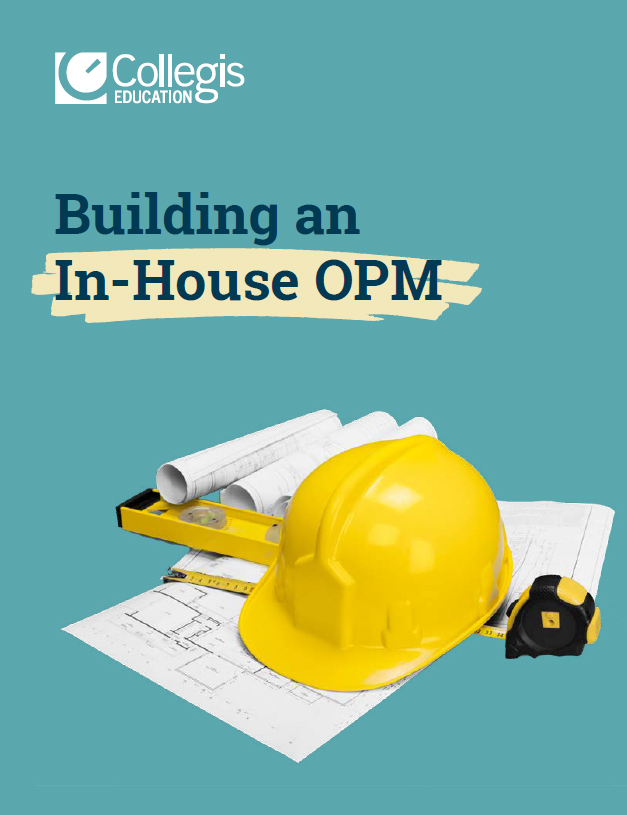
- Which of the 3 models suits your objectives and timeline
- How to objectively assess current capabilities and infrastructure
- Planning for a transition period as revenue and enrollment get back up to speed
- Finding the right partners to fill gaps and help in-house teams gain expertise
- How to prepare the culture and gain buy-in from stakeholders
At Collegis, we’ve partnered with multiple schools to successfully navigate this process to avoid common pitfalls and help you build in-house capabilities. Fill out the form to download the ebook now.
Download Now
Additional Resources
Transform Challenges Into Opportunities
Facing challenges in enrollment, retention, or tech integration? Seeking growth in new markets? Our strategic insights pave a clear path for overcoming obstacles and driving success in higher education.
Unlock the transformative potential within your institution – partner with us to turn today’s roadblocks into tomorrow’s achievements. Let’s chat.
500+ employers share their views
As higher ed looks to create and retain partnerships with employers, they need to understand how employers perceive them and meet their urgent needs.
As part of an ongoing research series, Collegis and UPCEA, the leading association for professional, continuing and online education, partnered to survey over 500 employers to better understand their perceptions of partnering with a four-year higher ed institution on professional development programs and alternative credentials.

Insights from the report include:
- The changing landscape of alternative credential programs
- Obstacles and opportunities of working with higher ed, according to employers
- The most important program features to help secure a partnership
Download Now
Transform Challenges Into Opportunities
Facing challenges in enrollment, retention, or tech integration? Seeking growth in new markets? Our strategic insights pave a clear path for overcoming obstacles and driving success in higher education.
Unlock the transformative potential within your institution – partner with us to turn today’s roadblocks into tomorrow’s achievements. Let’s chat.
As institutions rethink their online program management (OPM) partnerships, many are exploring alternative models that provide greater flexibility, cost control, and strategic alignment. However, transitioning away from an OPM provider is a complex process that requires careful planning to minimize disruption and ensure long-term success.
Check out the infographic below for an outlined, step-by-step approach to navigating this transition efficiently.
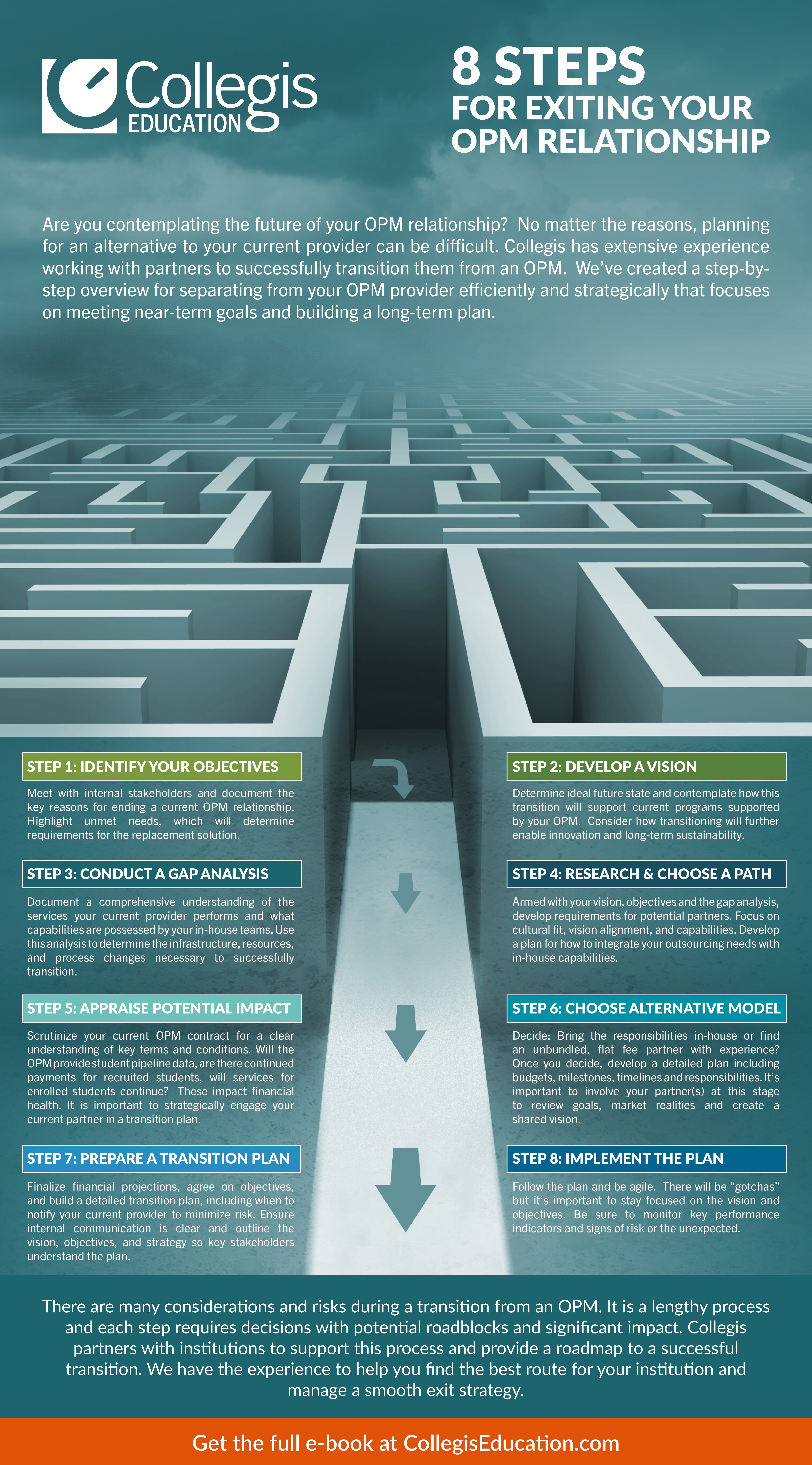
Successfully exiting an OPM relationship requires clear objectives, strategic planning, and the right partnerships to ensure a smooth transition. Institutions that take a data-driven, student-centered approach can maintain enrollment momentum while gaining greater control over their online programs.
Download our eBook for a more detailed guide on navigating this transition.
Break Free From Your OPM
Take control of your online programs. Explore your options for building a smarter strategy by downloading the eBook today.
Enablement vs. Management: Reconsidering the Traditional OPM Model
Institutions looking to expand their footprint while meeting student expectations may be considering the right partner to help grow their online programs. There are two common types of partnerships: the traditional Online Program Management (OPM) model and the alternative fee-for-service model.
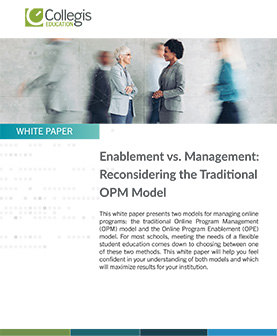
In this white paper, you’ll learn about:
- Shared responsibilities, not shared revenue
- Transparency
- A data-driven approach
- A whole-institution view
An experienced strategic partner like Collegis Education can help schools successfully own the future of their online courses and programs.
Collegis operates as an extension of your team, enabling you with data insights, technology, knowledge and best practices to manage your own online portfolio while we help you develop critical skills internally, leveraging the depth and breadth of our expertise as needed.
Learn more about the support we offer for Enrollment Growth.
Download Now
Transform Challenges Into Opportunities
Facing challenges in enrollment, retention, or tech integration? Seeking growth in new markets? Our strategic insights pave a clear path for overcoming obstacles and driving success in higher education.
Unlock the transformative potential within your institution – partner with us to turn today’s roadblocks into tomorrow’s achievements. Let’s chat.
A Guide to Exiting from Your OPM
Are you looking for ways to position your institution for long-term success? Perhaps it’s time to consider if your current OPM is still the right fit. Black box marketing tactics, non-transparent revenue share models and regulatory pressure are among the many reasons institutions are looking to alternative solutions to the traditional OPM. Whatever your reasons may be, planning a transition entails navigating a complex and multifaceted process that requires careful planning and execution.
Gathered from our experience helping other schools in similar situations, we have developed 8 steps to consider when exiting your OPM relationship.
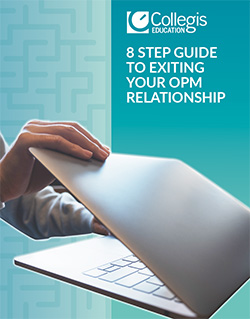
What’s Inside?
This guide provides an overview of key considerations and tasks for exiting an OPM relationship:
- Identifying your motivations
- Evaluating internal capacity
- Understanding institutional impact
- Building a transition team
Download Now
Transform Challenges Into Opportunities
Facing challenges in enrollment, retention, or tech integration? Seeking growth in new markets? Our strategic insights pave a clear path for overcoming obstacles and driving success in higher education.
Unlock the transformative potential within your institution – partner with us to turn today’s roadblocks into tomorrow’s achievements. Let’s chat.
As demand for online education continues to grow, many institutions are looking to expand their online programs to reach more students, drive enrollment, and stay competitive. While some schools work with online program management (OPM) providers, others are choosing to scale online learning in-house.
If your institution is considering launching or growing online programs independently, our latest infographic outlines the critical skills, resources, and strategies you’ll need for success.
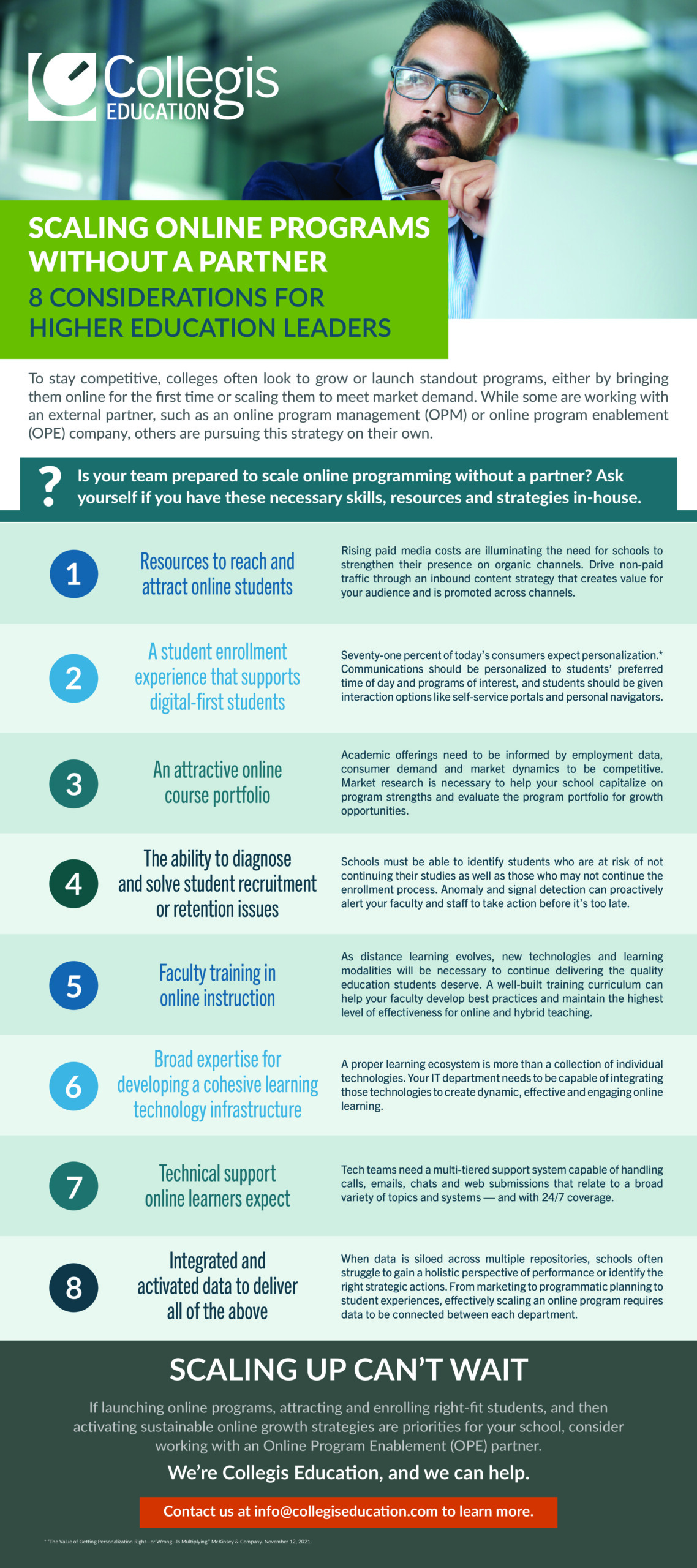
Innovation Starts Here
Higher ed is evolving — don’t get left behind. Explore how Collegis can help your institution thrive.
More than 500 employers share their perceptions
As the workforce evolves, many employers are considering the relevance and use of alternative credentials for upskilling or reskilling employees. This reimagining of workforce education provides an opportunity for higher ed leaders to partner with employers on microcredential programs that drive a funnel of enrollments.
Collegis teamed up with UPCEA to survey more than 500 employers about their perceptions of microcredentials and interest in partnering with colleges and universities on these non-degree programs.
Download the report to receive insights on:
- What incentivizes employers to work with higher ed institutions
- Employer valuation of alternative credentials
- Employer use of alternative credentials in lieu of degrees in the hiring process
Download Now
Transform Challenges Into Opportunities
Facing challenges in enrollment, retention, or tech integration? Seeking growth in new markets? Our strategic insights pave a clear path for overcoming obstacles and driving success in higher education.
Unlock the transformative potential within your institution – partner with us to turn today’s roadblocks into tomorrow’s achievements. Let’s chat.
Part one of a three-part series.
As the popularity of online higher education programs grows, the need to have the right infrastructure and processes in place to attract, support and retain these students – and understand how they differ from on-campus students – grows more important. Most institutions are not equipped to support, at scale, the kinds of flexible online and hybrid courses and programs that today’s online students require.
That’s why so many colleges and universities have sought the help of online program management (OPM) companies to transition their established on-campus programs online in exchange for a share of tuition over a set number of years. However, as competition increases and views on traditional degree formats shift, these revenue-share agreements may be hurting institutions in the long run.
6 Reasons OPMs Can Hurt Schools in the Long Run
One of the primary reasons online program management companies appear attractive is that, under a revenue-share model, schools can largely bypass the upfront costs required to quickly launch new online programs. While this partnership model worked well when competition in the online space was smaller, it is now proving to have big risks and long-term limitations for institutions. These include:
1. Long-term, restrictive contracts that are difficult to terminate.
Most OPM contracts are between five and ten years with limited remediation options for institutions when enrollment objectives aren’t met.
2. Complete lack of transparency around performance.
Due to the nature of revenue-share contracts, an OPM company has no incentive to share its strategies and data (especially in marketing and admissions). Schools may not know what tactics are driving performance. This prevents the school from learning the operational and analytical nuances of operating at scale and understanding why certain decisions are made.
3. Conflicting objectives.
OPMs typically focus their efforts on the specific programmatic offerings with the highest profit margin and are highly selective in what they are willing to support, which may not align with an institution’s mission and needs. OPMs also may not align with a school’s culture; for example, some OPMs’ tactics taken on behalf of an institution may be seen as aggressive and not in line with a school’s ethos. In addition, some tactics OPMs use are in direct competition with tactics the institution is already employing to recruit students for non-OPM–supported programs.
4. No development of internal online infrastructure.
OPMs operate in a very closed, “black-box” manner. Strategies are not shared with the school and technology benefits are only realized by the OPM. When the relationship ends, schools are left without the capabilities, expertise and recruiting pipeline, as well as the data, insights or knowledge of what worked or what it took to launch their online programs and grow their enrollments.
5. Lack of control around decisions and strategies.
In a revenue-share agreement with an OPM, the company often has ultimate decision-making authority on non-academic processes. This can cause friction with faculty – and leave schools with no way to intervene.
6. Less revenue generation over the long ter
While OPMs help schools see revenue right away as enrollments grow, revenue-share agreements eat away at revenue over time. OPMs often collect more than 50 percent of revenue over the course of several years.
There’s a Better Way.
If your institution is already working with an OPM to support online programs, or is looking for help doing so, an online program enablement (OPE) company may be a better option to improve your institution’s long-term health and innovation, as well as enable you to own the future of your online programs.
OPE companies differ from their online program management counterparts in several ways, including the types of services offered, the programs supported and the approaches used to achieve results. Most notably, OPEs offer unbundled services and do not rely on revenue-share agreements to fund the partnership. Because of this, OPEs are an ideal partnership option for schools since the institution is able to build internal capacity and intelligence that can be leveraged across the organization and programs to improve marketing, enrollment and support services.
An OPE provider like Collegis Education can help schools successfully own the future of their online courses and programs.
This article is part of a series about OPMs and OPEs. Read part two, OPE: A Better Alternative for Long-Term Growth.
Innovation Starts Here
Higher ed is evolving — don’t get left behind. Explore how Collegis can help your institution thrive.




